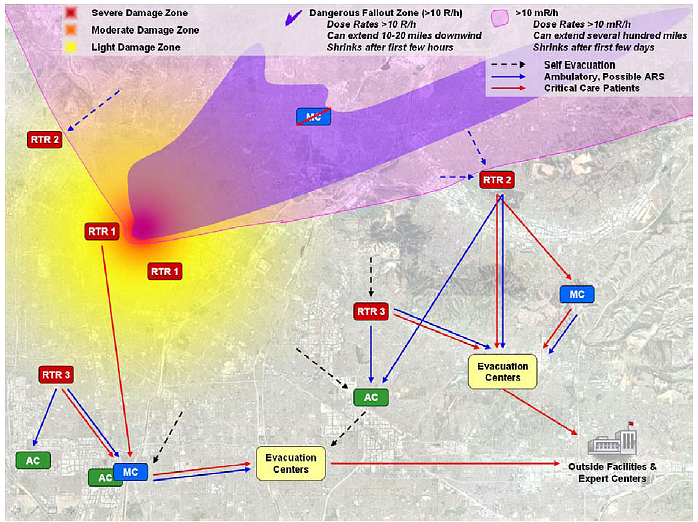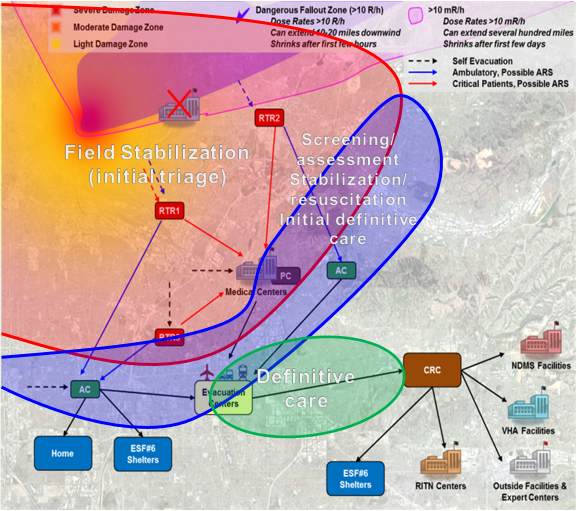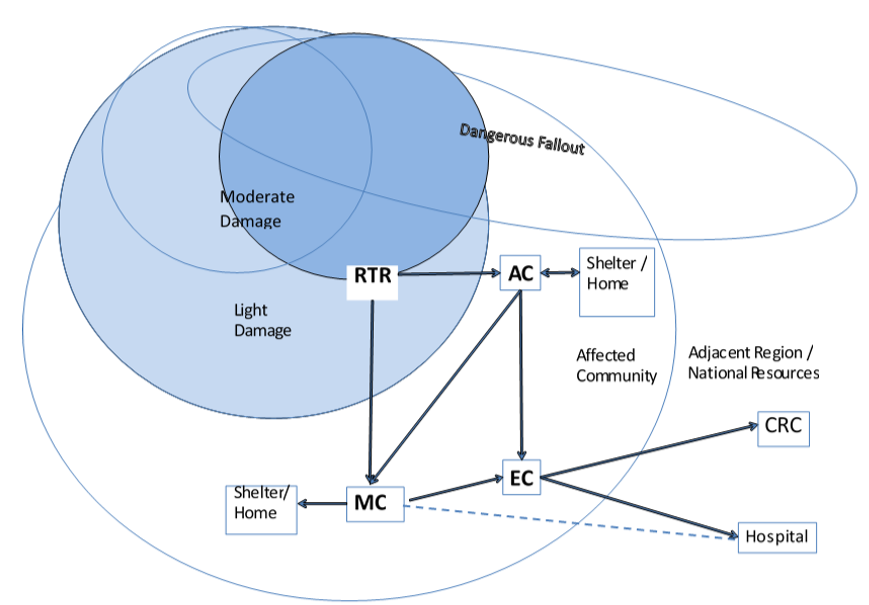Radiation Triage, Treat, and Transport System (RTR) after a
Nuclear Detonation:
Venues for the Medical Response

The RTR system for a nuclear detonation response: theoretical zones in a 10 KT nuclear explosion at ground level
Source: Planning Guidance for Response to a Nuclear Detonation, Second edition, 6/2010 (PDF - 2.62 MB) (National Security Staff, Interagency Policy Coordination Subcommittee for Preparedness & Response to Radiological and Nuclear Threats, Figure 4.1)
- RTR1 - Sites would have victims with major trauma and relatively high levels of radiation. This limits responder time and would be associated with relatively severe victim injuries; many victims may be expectant. The location will be near the severe damage (SD) zone external border and/or in the moderate damage (MD) zone. Rubble may prevent entry into this zone.
- RTR2 - Sites will be for triaging victims with radiation exposure only or possibly with minor trauma. The location will be along the outer edges of the Dangerous Fallout (DF) zone and the Light Damage (LD) zone and will have some elevated levels of radiation. Most victims are expected to be ambulatory.
-
RTR3 - Sites are collection points where radiation
is not present and will allow occupation for many
hours or more. Victims are anticipated to have limited
trauma, such as glass injury, and most victims will be
ambulatory, including people displaced by the explosion who
have no injury or exposure. Extensive self-evacuation is
likely to be observed at these sites. These may occur in the
LD zone and beyond. RTR3 sites are likely to form in various
locations spontaneously or by direction of the Incident
Commander as opposed to preplanned Assembly Center (AC)
sites. Changes in the fallout pattern due to wind shifts may
require some RTR3 sites to change roles (to RTR2) or
possibly be abandoned.
- Medical care (MC) sites - includes hospitals, healthcare facilities and alternative care sites for those who need immediate medical care
- Assembly centers (AC) - collection points for displaced persons or those who do not need immediate medical attention.
-
Evacuation centers (EC) - for organized
transportation
-
More Details about RTR System: Where Clinical Activities
Occur

Type
Location
Operator
Time
Function
RTR1
Damage zones and around blast area
Local
< 48 hrs
Trauma assessment, triage, stabilization
RTR2
Edge of the fallout zones
Local
< 48 hrs
Trauma assessment, triage, stabilization (decon if possible)
RTR3
Outside damage and fallout zones
Local
< 48 hrs
Trauma assessment, triage, stabilization (decon if possible)
Assembly/ Screening Centers
In local area and region outside danger zones
Local, NGOs, MRC
1 day – 1 week
Radiation screening, gross decon, initial assessment
Medical Centers
In local area and region
Local, NGOs, (VHA, NDMS, FMS)
1 day – 1 month
Radiation screening, decon, triage, trauma and emergency care
Local / Distant ESF#6 Shelters
In local area and region / outside region
ESF #6
1 day – months
Mass care, routine medical, hematology, outpatient (distant)
Evacuation Centers
In local area and region
LSTTF, DOD, NDMS
< 1 week
Staging for casualty or patient transport
- The graphic above shows where various types of clinical activities are likely to occur
- The table above provides more details, including timing.
Community Response Locations after a Nuclear Detonation

RTR = Radiation Triage, Treatment, and Transport
AC = Assembly Center,
MC= Medical Care facility,
EC = Evacuation Center,
CRC = Community Reception Center.
Original Source: Modified from Hrdina CM, Coleman CN,
Bogucki S et al.,
The "RTR" Medical Response System for Nuclear and
Radiological Mass-Casualty Incidents: A Functional
Triage-Treatment-Transport Medical Response Model. Prehospital Disaster Medicine. 24(3):167-178.
This figure adapted from Hick JL, Coleman CN: Population-based
triage, treatment, and evacuation functions following a
nuclear detonation.
HHS/TRACIE monograph, page 5
Differences between CRC and AC
|
|
Assembly Center (AC) |
Community Reception Center (CRC) |
|---|---|---|
|
Location |
Close to detonation |
Far from detonation |
|
Resources in community |
Scarce |
Adequate |
|
Goal |
Rapid assessment for total body radiation exposure |
Detailed assessment for external and internal residual radiation |
|
Resources required |
Minimal |
Extensive |
|
Decontamination |
Gross/Containment |
Technical |
|
Registration/Interview |
Minimal |
Detailed |
|
Other functions on site? |
Likely - some medical care, cytokine administration, possible shelter/support operations |
Unlikely |
|
Time to initial operation |
18-24 hours |
48-96 hours or more |
Source: Hick JL, Coleman CN: Population-based triage, treatment, and evacuation functions following a nuclear detonation. HHS/TRACIE monograph, page 7.
See also:
- Damage Zones after a Nuclear Detonation & "Zoned Approach" to the Response
- Damage Zones after Nuclear Detonation: Idealized Maps
- Damage Zones, Radiation Zones and Likely Rescue Activities after a Nuclear Detonation: Table
- Time Sequenced Size of Dangerous Fallout Zone and 0.01 R/Hour Boundary after a Nuclear Detonation

